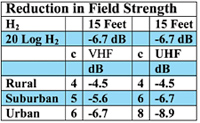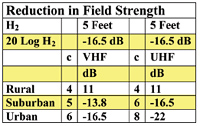Obstacles to DTV Reception(2)

In my August 19 column, I noted that the FCC assumed that DTV antennas are 30 feet above ground. This is quite reasonable for those living in a two-story home such as those typical in our older cities, but since World War II there has been a mass exodus from our cities to suburbia where the much lower cost of land allowed us to build single story homes. This means that homes in our suburbs, with a rooftop antenna are only about half as high as the FCC planned for. Significantly lower field strength is to be expected.
The International Telecommunications Union Recommendation P.370-7 gives us an equation relating changes in field strength for variat/Users/bsmith/Desktop/TVT Nov18/f-dave.docions in antenna height above ground. Over a range from 1.5 meters to 40 meters, field strength can vary substantially from what it is at 10 meters (Height Gain (dB) = c/6 * 20 (Log H2 / 10)). The height gain factor refers to the receiving antenna height above ground. c varies with the locale and TV Band.
Table 1 deals with a rooftop antenna on a single-story building.
The signal loss for H2 = 15 feet can be compensated for with a mast-mounted Low Noise Pre-amplifier.
Table 2 deals with the height above ground of indoor antennas on the first floor of a home.
These signal losses cannot be compensated for by means of a Low Noise Pre-amplifier.

Table 1

Table 2 This is because indoor antennas do not offer significant gain.
These are height loss calculations. An additional factor must also be considered for indoor antennas, called the "Building Loss Factor." The only data we have on this is from Europe, so I do not consider it to be valid for homes in North America.
We will save the matter of Building Loss Factor for another column.
'TREE SWAY'
I also noted that the FCC planning process did not take into account ground clutter; that is, in one word, vegetation. What is called suburbia today was rural (mostly cleared farm land) 50 years ago when the field strength measurements were carried out and which became the basis for the FCC Propagation Statistics.
Recently, I visited the home of a friend's mother who lives in a suburb of Portland, Ore. That suburb had perhaps 20,000 residents 60 years ago; now it has 89,000. Developers planted trees in the cleared farm land, and today those trees are mature and far taller than the single-story homes those developers built. In Oregon, most trees are evergreens and they have no leaves to drop in the fall. Over time residents planted more trees and bushes, lots of bushes and they too have grown up.
The result is erratic DTV reception with the antenna in the attic (H2 = 15 feet), and there is some building attenuation in play here because the antenna is hidden in the attic.
There is a lot of Building Loss here because there are no windows in most attics and most TV signal penetration of exterior walls is through the windows, not through the walls. In fact, many walls are highly reflective of RF signals (think of aluminum siding or aluminum foil-backed thermal insulation in exterior walls).
Recently, heat-reflecting double-pane windows have been mandated in some communities. These have a semi-transparent metallic film, which reflects heat and TV signals. I have measured about 10 dB of signal loss due to this reflective coating.
What Linley Gumm and I found at this home was that we could attenuate the signal by 15 dB and reception appeared at first to be OK. But within a minute or two, we noticed the audio was breaking up, and soon we had blocking; the picture started to break up too. The signal power was fluctuating about 15 dB on this particular UHF signal.
There was only a slight wind. What was changing is called "Tree Sway." The nearby trees dwarf the residential buildings. When these trees are wet, this effect is even stronger. We recommended that our friend install an antenna atop a 10-foot mast mounted to the brick chimney so that it is above the rooftops. Our friend reminded us that the day we came was warm and sunny, and when it rains, that channel simply vanishes.
INSIDE VS. OUTSIDE
Linley calculated that this site is 20.7 km from the transmitter and there would be a line-of-sight path between the transmit antenna and the rooftop, except for the trees, of course.
This station is radiating 1000 kW ERP from an omnidirectional antenna 560 meters above average terrain. The beam angle from the center of radiation is 1.5 degrees below the horizon. DTV transmitting antennas typically tilt the axis of their beam downwards so the beam axis is very close to the ray path to this site and we can assume the ERP of this station along the ray path is almost 1000 kW. Linley and I had previously visited the transmitter and from measurements we made, we believe that it was in good operational order.
More recently, Linley made a set of measurements at his home, which is nearer the TV towers that the site referred to above. His results are given in Table 3.
This data is referenced to the signal from an indoor antenna in the family room. If he had the same antenna outside at the same height above ground, the gain would be from 11 to 24 dB. This suggests the range of building loss factor vs. frequency for this particular building at this particular site.

Table 3: Comparison of DTV Signal Levels at a Single Level Home With this antenna in his attic, the gains are much less because the building loss factor is even higher for the attic (no windows in the attic), even though the antenna is somewhat higher. Most of the signal inside the home came through the windows. If the windows have a heat-reflecting treatment, the losses would run about 10 dB higher.
If this antenna were installed above the rooftop the gain would be between 17 to 31 dB!
Looking at it the other way 'round, the attic location is worse than the rooftop location by 8 to 14 dB. That might not have mattered with analog TV this close to the transmitters, but in this case it means lost channels with DTV.
You will notice that for channel 12, the signal inside the attic exceeded that outside, above the rooftop by 2 dB, but the signal outside appears to be suffering from a close-in echo, which happens to be out-of-phase with the direct signal.
When these tests were made, the roof was dry. I'll bet when the roof is wet, this +3 dB will turn highly negative.
Linley Gumm's data (above) greatly enhances the message this writer wanted to convey to his readers. Thanks, Linley.
Stay tuned.
Charles Rhodes is a consultant in the field of television broadcast technologies and planning. He can be reach via e-mail atcwr@bootit.com.
The professional video industry's #1 source for news, trends and product and tech information. Sign up below.
